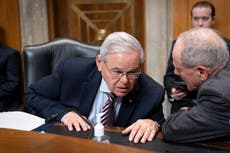Iran says engineer killed in ‘accident’ at military base
Iran’s missile programme has suffered a series of mysterious incidents

An engineer has been killed in an unexplained incident at a major Iranian military and weapons development base, state TV in Tehran has reported.
Iran’s defence ministry said the “accident” happened on Wednesday afternoon in a research centre at the Parchin military complex, east of the capital Tehran. The engineer who died was named as Ehsun Ghadbeigi.
Another worker was hurt in the incident but no further details were given by the authorities.
Officials said an investigation was underway.
Parchin is home to a military base where the International Atomic Energy Agency (IAEA) previously said it suspected Iran conducted tests of explosive triggers that could be used in nuclear weapons.
Iran has long denied seeking nuclear weapons, though the IAEA previously said Iran had done work in “support of a possible military dimension to its nuclear programme” that largely halted in late 2003.
Western concerns over the Iranian atomic programme led to sanctions and eventually to Tehran’s 2015 nuclear deal with world powers.
Howver, the US, under Donald Trump, unilaterally withdrew from the agreement in May 2018, and sought further isolation of Iran, imposing new sanctions upon Tehran.
Under President Biden, fragile talks to restore an agreeement are continuing but, so far, have not led to any deal.
Tehran enriches uranium up to 60 per cent purity - its highest level and a short technical step from weapons-grade levels of 90 percent.
In 2015, the IAEA’s then-director-general visited one suspected weapons programme site at Parchin and inspectors took samples there for analysis.
Iran’s missile and space programmes have suffered a series of mysterious explosions in recent years.
A giant unexplained blast struck in the area of Parchin in the summer of 2020, rattling the capital and sending a massive fireball into the sky near Tehran.
It also comes just days after the assassination of an Iranian military officer, Col Hassan Sayyad Khodai, in Tehran.
He was gunned down inside his car on Sunday afternoon, and the New York Times has reported that an intelligence official had told the US that it was behind Khodai’s killing.
With agencies
Join our commenting forum
Join thought-provoking conversations, follow other Independent readers and see their replies
Comments

Bookmark popover
Removed from bookmarks